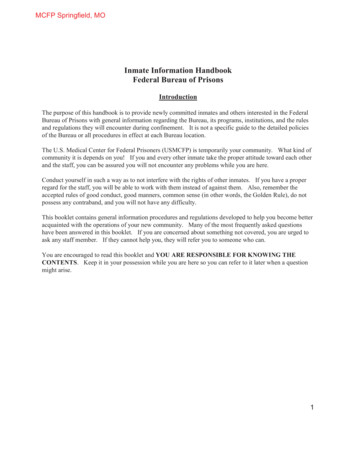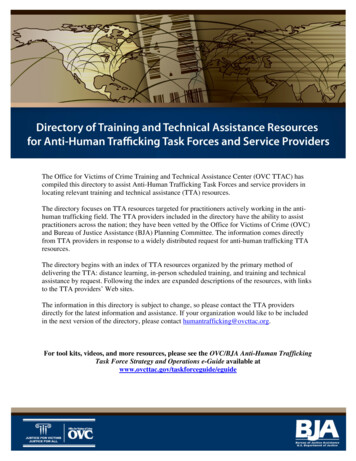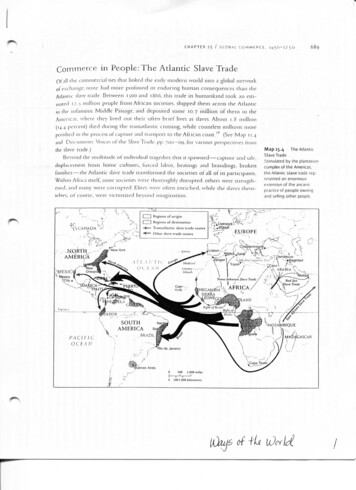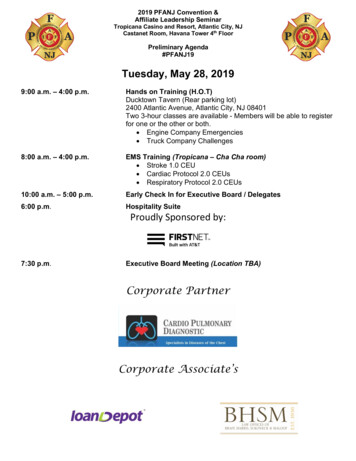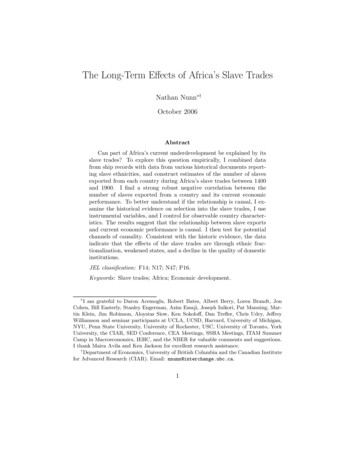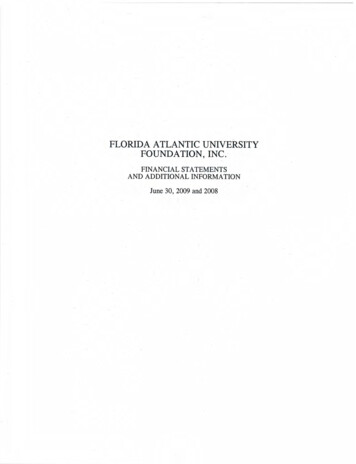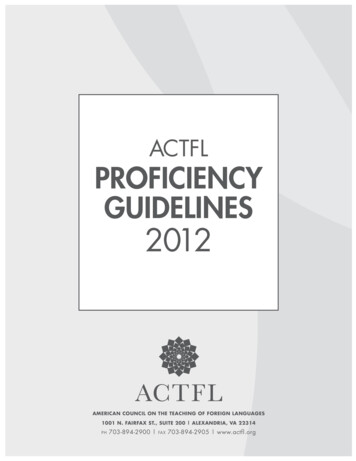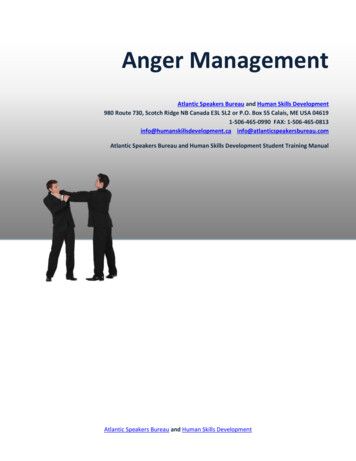
Transcription
Anger ManagementAtlantic Speakers Bureau and Human Skills Development980 Route 730, Scotch Ridge NB Canada E3L 5L2 or P.O. Box 55 Calais, ME USA 046191-506-465-0990 FAX: 1-506-465-0813info@humanskillsdevelopment.ca info@atlanticspeakersbureau.comAtlantic Speakers Bureau and Human Skills Development Student Training ManualAtlantic Speakers Bureau and Human Skills Development
TABLE OF CONTENTSModule One: Getting Started .5Workshop Objectives . 5Pre-Assignment Review . 6Module Two: Understanding Anger .7The Cycle of Anger . 7Understanding Fight or Flight . 9Common Myths about Anger. 10Case Study. 11Module Two: Review Questions. 12Module Three: Do’s and Don’ts . 13Unhelpful Ways of Dealing with Anger. 13Helpful Ways of Dealing with Anger . 14Case Study. 15Module Three: Review Questions . 16Module Four: Gaining Control . 17A Word of Warning . 17Using Coping Thoughts . 18Using Relaxation Techniques . 19Blowing Off Some Steam . 20Case Study. 21Module Four: Review Questions . 22Module Five: Separate the People from the Problem . 23Objective vs. Subjective Language . 23Atlantic Speakers Bureau and Human Skills Development
Identifying the Problem . 25Using “I” Messages . 25Case Study. 26Module Five: Review Questions . 27Module Six: Working on the Problem . 28Using Constructive Disagreement . 28Negotiation Tips. 29Building Consensus . 30Identifying Solutions . 30Case Study. 31Module Six: Review Questions . 32Module Seven: Solving the Problem . 34Choosing a Solution . 34Making a Plan . 35Getting it Done . 35Case Study. 36Module Seven: Review Questions . 37Module Eight: A Personal Plan. 38Understanding Hot Buttons . 38Identifying Your Hot Buttons . 39A Personal Anger Log . 39Case Study. 40Module Eight: Review Questions . 41Module Nine: The Triple A Approach . 42Alter . 42Avoid . 43Atlantic Speakers Bureau and Human Skills Development
Accept . 44Case Study. 44Module Nine: Review Questions . 45Module Ten: Dealing with Angry People . 46Understanding the Energy Curve . 46De-escalation Techniques . 48When to Back Away and What to Do Next . 50Case Study. 51Module Ten: Review Questions . 52Module Eleven: Pulling It All Together . 53Process Overview . 53Putting It into Action. 54Case Study. 55Module Eleven: Review Questions . 56Module Twelve: Wrapping Up . 57Words from the Wise . 57Atlantic Speakers Bureau and Human Skills Development
Holding on to anger is like grasping a hotcoal with the intent of throwing it atsomeone else; you are the one who getsburned.BuddhaModule One: Getting StartedWelcome to the Anger Management workshop. Benjamin Franklinonce said, “In this world, nothing can be said to be certain, exceptdeath and taxes.” We would like to add a third item to his list:anger. Anger can be an incredibly damaging force, costing peopletheir jobs, personal relationships, and even their lives when it getsout of hand. However, since everyone experiences anger, it isimportant to have constructive approaches to manage it effectively.This workshop will help teach participants how to identify theiranger triggers and what to do when they’re angry.Workshop ObjectivesResearch has consistently demonstrated that when clear goals are associated withlearning that the learning occurs more easily and rapidly. With that in mind, let’sreview our goals for today.By the end of this workshop, participants will be able to: Understand anger dynamics in terms of the anger cycle and the fight or flight theory. Know common anger myths and their factual refutations. Know the helpful and unhelpful ways of dealing with anger. Know techniques in controlling anger, particular reading anger warning signs, using copingthoughts, exercising relaxation techniques and blowing off steam. Understand the difference between objective and subjective language. Know tips in identifying the problem. Express a feeling or position using I-messages.Page 5 Atlantic Speakers Bureau and Human Skills Development
Know skills and techniques in making a disagreement constructive, including effectivenegotiation and solution-building. Reflect on one’s hot buttons and personal anger dynamics. Know alter, avoid and, accept ways of responding to an anger-provoking situation. Understand the energy curve and how it can help in responding to someone else’s anger. Learn and practice de-escalation techniques. Gain an integrated view of anger management and how it can be best practiced.Pre-Assignment ReviewThe purpose of the Pre-Assignment is to get participants thinking about the AngerManagement strategies they are already using and where they need to improve.As a pre-assignment, we asked participants to think of a situation where they hadexperienced anger, preferably one that no longer affects them in the presenttime.We also asked them to recall the exact symptoms they experienced, and the way they responded to thesymptoms. The following guide questions can help during this process:During your anger incident,1What symptoms did you experienceA. Physically?B. Mentally?C. Emotionally?D. Behaviorally?2. What was your response to your anger symptoms?3. Was your response helpful? If yes, in what way was it helpful? If your response was not helpful,in what way was it unhelpful?We asked the participants to take a moment to review their responses. The participants were alsorequested to keep their responses in mind during the workshop, as they can assist in grounding theideas to be presented into their practical lives.Page 6 Atlantic Speakers Bureau and Human Skills Development
Anger always comes from frustratedexpectations.Elliot LarsonModule Two: Understanding AngerBefore we discuss specific anger management strategies, it is helpfulto first understand the nature of anger. While most are familiar withthis emotion, not everyone is aware of its underlying dynamics. Inthis module, we will discuss the cycle of anger, the fight or flightresponse, and common myths about anger.The Cycle of AngerAnger is a natural emotion that usually stems from perceived threat or loss. It’s apervasive emotion; it affects our body, thoughts, feelings, and behavior. Anger isoften described in terms of its intensity, frequency, duration, threshold, andexpression.Anger typically follows a predictable pattern: a cycle. Understanding the cycle ofanger can help us understand our own anger reactions, and those of others. It can also help us inconsidering the most appropriate response.Illustrated below are the five phases of the anger cycle: trigger, escalation, crisis, recovery, anddepression.CrisisEscalationRecoveryThe Cycleof AngerTriggerDepressionNormal/Page 7 Atlantic Speakers Bureauand Human Skills DevelopmentAdaptive Phase
1. The Trigger PhaseThe trigger phase happens when we perceive a threat or loss, and our body prepares to respond. Inthis phase, there is a subtle change from an individual’s normal/ adaptive state into his stressedstate. Anger triggers differ from person to person, and can come from both the environment orfrom our thought processes.2. The Escalation PhaseIn the escalation phase, there is the progressive appearance of the anger response. In this phase,our body prepares for a crisis after perceiving the trigger. This preparation is mostly physical, and ismanifested through symptoms like rapid breathing, increased heart rate, and raised blood pressure.Once the escalation phase is reached there is less chance of calming down, as this is the phasewhere the body prepares for fight or flight (to be discussed later).3. The Crisis PhaseAs previously mentioned, the escalation phase is progressive, and it is in the crisis phase that theanger reaction reaches its peak. In the crisis phase our body is on full alert, prepared to take actionin response to the trigger. During this phase, logic and rationality may be limited, if not impairedbecause the anger instinct takes over. In extreme cases, the crisis phase means that a person maybe a serious danger to himself or to other people.4. The Recovery PhaseThe recovery phase happens when the anger has been spent, or at least controlled, and there is nowa steady return to a person’s normal/ adaptive state. In this stage, reasoning and awareness of one’sself returns. If the right intervention is applied, the return to normalcy progresses smoothly.However, an inappropriate intervention can re-ignite the anger and serve as a new trigger.5. The Depression PhaseThe depression phase marks a return to a person’s normal/ adaptive ways. Physically, this stagemarks below normal vital signs, such as heart rate, so that the body can recover equilibrium. Aperson’s full use of his faculties return at this point, and the new awareness helps a person assesswhat just occurred. Consequently, this stage may be marked by embarrassment, guilt, regret, and ordepression.After the depression phase is a return to a normal or adaptive phase. A new trigger, however, can startthe entire cycle all over again.Below is an example of a person going through the five stages of the anger cycle.Josephine came home from work to see dirty plates left in the sink (trigger phase). She started to washthem, but as she was doing so she kept thinking about how inconsiderate her children are for notcleaning after themselves. She was already tired from work and does not need the extra chore. She feltthe heat in her neck and the tremble in her hands as she’s washing the dishes (escalation phase).Page 8 Atlantic Speakers Bureau and Human Skills Development
Feeling like she can’t keep it to herself any longer, she stormed up the room to confront her kids. In araised voice, she asked them how difficult could it be to wash the dishes. She told them that they aregetting punished for their lack of responsibility (crisis phase).Having gotten the words out, she felt calmer, and her heartbeat slowly returned to normal. She saw thather kids are busy with homework when she had interrupted them. She was also better able to hear theirreasoning, as they apologized (recovery phase).Josephine regretted yelling at her children and told them that she’s simply tired and it’s not their fault(depression phase).NOTE: How long each phase lasts differ from person to person. Some people also skip certain phases, orelse they go through them privately and/ or unconsciously.Understanding Fight or FlightThe Fight or Flight theory, formulated by Walter Cannon, describes how peoplereact to perceived threat. Basically, when faced with something that can harmus, we either aggress (fight) or withdraw (flight). It is believed that this reactionis an ingrained instinct geared towards survival.The fight or flight instinct is manifested in bodily ways. When faced with athreat, our body releases the hormones adrenaline, noradrenaline, and cortisol. These chemicals aredesigned to take us to a state of alertness and action. They result in increased energy, heart rate, sloweddigestion, and above normal strength.Understanding the fight or flight instinct can help us understand the dynamics of our anger response.The following are some of the implications of the fight and flight theory on anger management:First, the theory underscores how anger is but a natural response. There is no morality to anger. Anger isa result of perceived harm to self, whether physical or emotional.Second, this theory reminds us of the need to stay in control. When we are angry, our rational self getsoverridden by a basic survival instinct. There’s a need to act immediately. This instinct can then result inaggressiveness, over-reactivity, and hypervigilance, which are all contrary to rational and deliberateresponse. Conscious effort towards self-awareness and control is needed so that this instinct does notoverpower us.Page 9 Atlantic Speakers Bureau and Human Skills Development
Common Myths about AngerHere are five common myths about anger:1. Anger is a bad emotion.There is no such thing as a good or bad emotion; they are instinctual reactionsand we don’t make conscious decisions for them to come. In fact, some angerreactions are appropriate, such as the anger against discrimination, injustice, and abuse. What canbe judged as positive or negative/ healthy or unhealthy is how we react to anger.2. Anger needs to be ‘unleashed’ for it to go away.It’s true that anger needs to be expressed in order for symptoms to be relieved. However,expressing anger in verbally or physically aggressive ways are not the only way to ‘unleash’ anger.Nor is anger an excuse for a person to be aggressive. The expression of anger can be tempered byrationality and forethought.Note that venting anger does not necessarily results into the anger disappearing, although ventingcan relieve the symptoms. At times, processing personal experiences, seeing concrete change andgenuine forgiveness are needed for anger to go away.3. Ignoring anger will make it go away.Generally, all kinds of emotions do not disappear when ignored. The anger just gets temporarilyshelved, and will likely find other ways of getting expressed. It can get projected to another person,transformed into a physical symptom, or built up for a bigger future blow up. Some of our behaviorsmay even be unconscious ways of expressing anger.While there are situations when it’s inadvisable to express your anger immediately, the very leastyou can do is acknowledge that it exists.4. You can’t control your anger.This myth is related to the second one. As discussed earlier, the fight and flight instinct can makeanger an overwhelming emotion. However, this instinct does not mean that you’re but a slave toyour impulses. Awareness of anger dynamics and a conscious effort to rise above your anger canhelp you regain control of your reactions.5. If I don’t get angry, people will think I am a pushover.It’s true that a person can lose credibility is he makes rules and then ignores violations. However,anger is not the only way a person can show that there are consequences to violations. In fact, themost effective way of instilling discipline in others is to have a calm, non-emotional approach todealing with rule-breakers. Calm and rationality can communicate strength too.Page 10 Atlantic Speakers Bureau and Human Skills Development
Case StudyEver since he was a young boy, Jeff was known to have problems related to his anger management. Heused to get angry on other children whenever they played with his toys or wouldn’t allow him to join agame. As no one tried to understand Jeff and his condition, he grew up with a short temper which costhim a lot in his life. Jeff lost a total of 3 jobs and started living on a pension in a home with poorconditions.One day, Jeff miraculously decided to approach people and ask for their advice. He thought that thisway, he will be able to understand how anger works and help others get rid of theirs before it broughtconsequences. This way, Jeff learned a lot about the cycle of anger, its phases and also how to helpothers control it. He started working on building himself a career in this niche by taking courses andhelping people whenever he had free time. This has provided him with a nice income, but also madepeople understand which aspects of anger management were myths and which were facts.Page 11 Atlantic Speakers Bureau and Human Skills Development
Module Two: Review Questions1. How many phases are there in the Cycle of Anger?a)b)c)d)34562. Once a person returns to a normal or adaptive phase, a new trigger cannot start the entire cycleall over again.a) Trueb) False3. or describes how people react to a perceived threat.a)b)c)d)Win or loseRun or hideSmile or frownFight or flight4. Anger is a result of perceived harm to self, whether physical or .a)b)c)d)RealEmotionalNegotiatedEscalated5. Which is not a common myth about anger?a)b)c)d)Anger needs to be ‘unleashed’ for it to go awayIgnoring anger will make it go awayYou can’t control your angerYou can control your anger6. Anger is never an appropriate reaction?a) Trueb) FalsePage 12 Atlantic Speakers Bureau and Human Skills Development
How much more grievous are theconsequences of anger than the causes of it.Marcus AureliusModule Three: Do’s and Don’tsNow that we’ve established that anger is a natural, unavoidable,and instinctual reaction, let’s look at how we can respond toanger appropriately. In this module, we will discuss the dos anddon’ts in responding to anger.Unhelpful Ways of Dealing with AngerThe following are unhelpful ways of dealing with anger:1. DON’T ignore the anger.Some people respond to anger by not admitting, even to themselves, that theyare angry. Defense mechanisms often used to ignore anger include laughing an issue off, distractingone’s self from the problem, and trivializing the trigger’s impact.2. DON’T keep the anger inside.There are people who do recognize that they’re angry. However, they choose to obsess about theiranger in silence rather than express it. They can bear grudges for a long time. People like this, alsocalled ‘stuffers’, are more likely to develop hypertension compared to others. They are also likely tojust ‘explode’ one day, once the anger has built to the point that they can’t keep it inside anymore.3. DON’T get aggressive.The right to vent your anger doesn’t extend to doing it in ways that can hurt others, hurt yourself,and damage property. Aggression can be verbal or physical.4. DON’T get passive-aggressive.Passive-aggressiveness refers to indirect and underhanded means to get back at the person whomade you angry. Examples of passive-aggressive behaviors are gossiping, tardiness and backbiting.Page 13 Atlantic Speakers Bureau and Human Skills Development
5. DON’T use non-constructive communication styles.Avoid the use of indirect attacks and unproductive statements. These include blaming, labeling,preaching, moralizing, ordering, warning, interrogating, ridiculing and lecturing.Helpful Ways of Dealing with AngerThe following are helpful ways in dealing with anger:1. DO acknowledge that you are angry.It is important that you know how to recognize that you are angry, and giveyourself permission to feel it. This can be as simple as saying to yourself “I amangry.” Remember, you can’t control something you don’t admit exists!2. DO calm yourself before you say anything.In the previous discussions, we saw how there is a biological reason why anger can feeloverwhelming --- our body is engaged in a fight or flight response. It helps then to defer anyreactions until you have reached the return to normal/ adaptive phase of the anger cycle.Otherwise, you might end up saying or doing something that you’d later regret. Count 1 to 10!3. DO speak up, when something is important to you.This is the opposite to ‘keeping it all in.’ If a matter is important to you, so much so that keepingsilent would just result in physical and mental symptoms, then let it out. If it’s not possible to speakto the person concerned, at least look for a trusted friend or a mental health professional.4. DO explain how you’re feeling in a manner that shows ownership and responsibility for youranger.Take ownership and responsibility for your feelings. This makes the anger within your control (youcan’t control other people). One way to take ownership and responsibility for your anger is throughthe use of I-messages, which would be discussed in a later module.Page 14 Atlantic Speakers Bureau and Human Skills Development
Case StudyUnfortunate events happen all the times in most of our lives. This was also the case with Bella. Afterhaving to cope with a difficult family situation, she started to develop anger management issues whichmade her unable to build a career in a company. She used to get angry out of nothing and deal with heranger by trying to ignore it, keep it inside and trying to keep her calm, but these ideas only made herfeel weaker.Fortunately, Bella managed to get out of this situation thanks to a colleague who thought her a fewsecrets in order to make sure that she won’t lose her job. This way, Bella learned to how to acknowledgethat she is angry, but also how to calm herself and when to speak up. The tips helped make her regaincontrol and respond to anger in the logical and correct way.Page 15 Atlantic Speakers Bureau and Human Skills Development
Module Three: Review Questions1. Ignoring anger is a helpful coping tool.a) Truea) False2. Being aggressive can be projected verbally or physically.a) Trueb) False3. Saying to yourself “I am angry” is a simple way to acknowledge your anger.b) Truec) False4. Counting to 10 is not a useful way to try and calm down.a) Trueb) FalsePage 16 Atlantic Speakers Bureau and Human Skills Development
People who fly into a rage always make abad landing.Will RogersModule Four: Gaining ControlAnger is instinctual, yes. It is an emotion that comes unbidden andwe often don’t have a choice whether we would be angry or not.What we can do however, is take control of our anger when itcomes. In this module, we will discuss ways to gain control over ouranger. Specifically we will discuss recognizing warning signs, copingthoughts, relaxation techniques and ways to blow off steam.A Word of WarningThe first step in gaining control of anger is to recognize its warning signs. You have tobe aware of symptoms that your anger is about to build up, so that you can catchyourself early and make the necessary intervention. This process involves takingyourself from the ‘moment’ and observing your own reactions from a third personpoint of view.Warning signs of anger exists in a range. Some are very obvious; others very subtle.They differ from person to person.Signs of anger can be physical, mental, emotional, and behavioral.Physical signs of anger include: rapid heart rate difficulty breathing headache stomachache sweating feeling hot in the face and neck shakingMental signs of anger include:Page 17 Atlantic Speakers Bureau and Human Skills Development
difficulty concentratingobsessing on the situationthinking vengeful thoughtscynicismEmotional signs of anger include: sadness irritability guilt resentment feeling like you need to hurt someone needing to be alone needing to isolate one’s self numbnessBehavioral signs of anger include: clenching of fist pounding of fist on a wall/ table or any surface pacin
Anger Management Atlantic Speakers Bureau and Human Skills Development 980 Route 730, Scotch Ridge NB Canada E3L 5L2 or P.O. Box 55 Calais, ME USA 04619 1-506-465-0990 FAX: 1-506-465-0813 info@humanskillsdevelopment.ca info@atlanticspeakersbureau.com Atlantic Speakers Bureau and Human Skills Development Student Training Manual .



